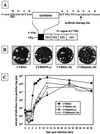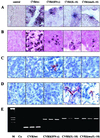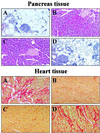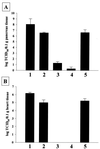Expression of immunoregulatory cytokines by recombinant coxsackievirus B3 variants confers protection against virus-caused myocarditis
- PMID: 11483764
- PMCID: PMC115063
- DOI: 10.1128/jvi.75.17.8187-8194.2001
Expression of immunoregulatory cytokines by recombinant coxsackievirus B3 variants confers protection against virus-caused myocarditis
Abstract
Clinical and laboratory investigations have demonstrated the involvement of viruses and bacteria as potential causative agents in cardiovascular disease and have specifically found coxsackievirus B3 (CVB3) to be a leading cause. Experimental data indicate that cytokines are involved in controlling CVB3 replication. Therefore, recombinant CVB3 (CVB3rec) variants expressing the T-helper-1 (T(H)1)-specific gamma interferon (IFN-gamma) or the T(H)2-specific interleukin-10 (IL-10) as well as the control virus CVB3(muIL-10), which produce only biologically inactive IL-10, were established. Coding regions of murine cytokines were cloned into the 5' end of the CVB3 wild type (CVB3wt) open reading frame and were supplied with an artificial viral 3Cpro-specific Q-G cleavage site. Correct processing releases active cytokines, and the concentration of IFN-gamma and IL-10 was analyzed by enzyme-linked immunosorbent assay and bioassays. In mice, CVB3wt was detectable in pancreas and heart tissue, causing massive destruction of the exocrine pancreas as well as myocardial inflammation and heart cell lysis. Most of the CVB3wt-infected mice revealed virus-associated symptoms, and some died within 28 days postinfection. In contrast, CVB3rec variants were present only in the pancreas of infected mice, causing local inflammation with subsequent healing. Four weeks after the first infection, surviving mice were challenged with the lethal CVB3H3 variant, causing casualties in the CVB3wt- and CVB3(muIL-10)-infected groups, whereas almost none of the CVB3(IFN-gamma)- and CVB3(IL-10)-infected mice died and no pathological disorders were detectable. This study demonstrates that expression of immunoregulatory cytokines during CVB3 replication simultaneously protects mice against a lethal disease and prevents virus-caused tissue destruction.
Figures





Similar articles
-
Recombinant coxsackievirus vectors for prevention and therapy of virus-induced heart disease.Int J Med Microbiol. 2008 Jan;298(1-2):127-34. doi: 10.1016/j.ijmm.2007.08.010. Epub 2007 Sep 25. Int J Med Microbiol. 2008. PMID: 17897883 Review.
-
The viral genetic background determines the outcome of coxsackievirus B3 infection in outbred NMRI mice.J Med Virol. 2007 Sep;79(9):1334-42. doi: 10.1002/jmv.20933. J Med Virol. 2007. PMID: 17607777
-
Development of a new mouse model for coxsackievirus-induced myocarditis by attenuating coxsackievirus B3 virulence in the pancreas.Cardiovasc Res. 2020 Aug 1;116(10):1756-1766. doi: 10.1093/cvr/cvz259. Cardiovasc Res. 2020. PMID: 31598635
-
Using recombinant coxsackievirus B3 to evaluate the induction and protective efficacy of CD8+ T cells during picornavirus infection.J Virol. 2001 Mar;75(5):2377-87. doi: 10.1128/JVI.75.5.2377-2387.2001. J Virol. 2001. PMID: 11160741 Free PMC article.
-
Viral damage or 'molecular mimicry'-placing the blame in myocarditis.Nat Med. 2000 Jun;6(6):631-2. doi: 10.1038/76199. Nat Med. 2000. PMID: 10835674 Review. No abstract available.
Cited by
-
Interferon-induced protection against foot-and-mouth disease virus infection correlates with enhanced tissue-specific innate immune cell infiltration and interferon-stimulated gene expression.J Virol. 2010 Feb;84(4):2063-77. doi: 10.1128/JVI.01874-09. Epub 2009 Dec 2. J Virol. 2010. PMID: 19955313 Free PMC article.
-
Use of IFN-Based Biotherapeutics to Harness the Host Against Foot-And-Mouth Disease.Front Vet Sci. 2020 Aug 11;7:465. doi: 10.3389/fvets.2020.00465. eCollection 2020. Front Vet Sci. 2020. PMID: 32851039 Free PMC article. Review.
-
Interferons in enteroviral heart disease: modulation of cytokine expression and antiviral activity.Med Microbiol Immunol. 2004 May;193(2-3):149-54. doi: 10.1007/s00430-003-0200-3. Epub 2003 Sep 12. Med Microbiol Immunol. 2004. PMID: 13680216
-
Differential interferon responses enhance viral epitope generation by myocardial immunoproteasomes in murine enterovirus myocarditis.Am J Pathol. 2009 Aug;175(2):510-8. doi: 10.2353/ajpath.2009.090033. Epub 2009 Jul 9. Am J Pathol. 2009. PMID: 19590042 Free PMC article.
-
Silencing MicroRNA-155 Attenuates Cardiac Injury and Dysfunction in Viral Myocarditis via Promotion of M2 Phenotype Polarization of Macrophages.Sci Rep. 2016 Mar 2;6:22613. doi: 10.1038/srep22613. Sci Rep. 2016. PMID: 26931072 Free PMC article.
References
-
- Andino R, Silvera D, Suggett S D, Achacoso P L, Miller C J, Baltimore D, Feinberg M B. Engineering poliovirus as a vaccine vector for the expression of diverse antigens. Science. 1994;265:1448–1451. - PubMed
-
- Chomczynski P, Sacchi N. Single-step method of RNA isolation by acid guanidinium thiocyanate-phenol-chloroform extraction. Anal Biochem. 1987;162:156–159. - PubMed
-
- Gauntt C J, Higdon A L, Arizpe H M, Tamayo M R, Crawley R, Henkel R D, Pereira M E, Tracy S M, Cunningham M W. Epitopes shared between coxsackievirus B3 (CVB3) and normal heart tissue contribute to CVB3-induced murine myocarditis. Clin Immunol Immunopathol. 1993;68:129–134. - PubMed
MeSH terms
Substances
LinkOut - more resources
Full Text Sources
Molecular Biology Databases

